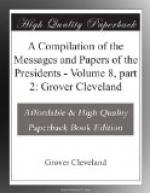firmness” of George Clinton when as Vice-President
he gave his casting vote in the United States Senate
against the bank bill, February 20, 1811. In 1812
was elected to the senate of New York from the middle
district as a Clinton Republican, defeating Edward
P. Livingston; took his seat in November of that year,
and became thereby a member of the court of errors,
then composed of senators in connection with the chancellor
and the supreme court. As senator he strenuously
opposed the charter of “The Bank of America,”
which was then seeking to establish itself in New York
and to take the place of the United States Bank.
Though counted among the adherents of Madison’s
Administration, and though committed to the policy
of declaring war against Great Britain, he sided with
the Republican members of the New York legislature
in 1812, and supported De Witt Clinton for the Presidency.
In the following year, however, he dissolved his political
relations with Clinton and resumed the entente
cordiale with Madison’s Administration.
In 1815, while still a member of the senate, was appointed
attorney-general of the State, superseding the venerable
Abraham Van Vechten. In 1816 was reelected to
the State senate, and, removing to Albany, formed a
partnership with his life-long friend, Benjamin F.
Butler. In the same year was appointed a regent
of the University of New York. Supported De Witt
Clinton for governor of New York in 1817, but opposed
his reelection in 1820. In 1819 was removed from
the office of attorney-general. February 6, 1821,
was elected United States Senator. In the same
year was chosen from Otsego County as a member of
the convention to revise the constitution of the State.
Took his seat in the United States Senate December
3, 1821, and was at once made a member of its Committees
on the Judiciary and Finance. For many years
was chairman of the former. Supported William
H. Crawford for the Presidency in 1824. Was reelected
to the Senate in 1827, but soon resigned his seat
to accept the office of governor of New York, to which
he was elected in 1828. Was a zealous supporter
of Andrew Jackson in the Presidential election of 1828,
and in 1829 became premier of the new Administration.
As Secretary of State he brought to a favorable close
the long-standing feud between the United States and
England with regard to the West India trade. Resigned
his Secretaryship in June, 1831, and was sent as minister
to England. The Senate refused in 1832 to confirm
his nomination by the casting vote of John C. Calhoun,
the Vice-President. In 1832 was elected Vice-President
of the United States, and in 1833 came to preside over
the body which a year before had rejected him as a
foreign minister. On May 20, 1835, was formally
nominated for the Presidency, and was elected in 1836
over his three competitors, William H. Harrison, Hugh
L. White, and Daniel Webster, by a majority of 57
in the electoral college, but of only 25,000 in the
popular vote. On May 5, 1840, was nominated for




